By Robert Bruce
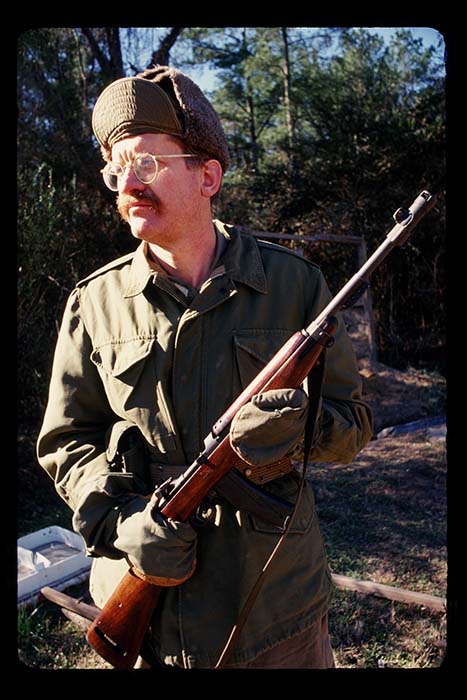
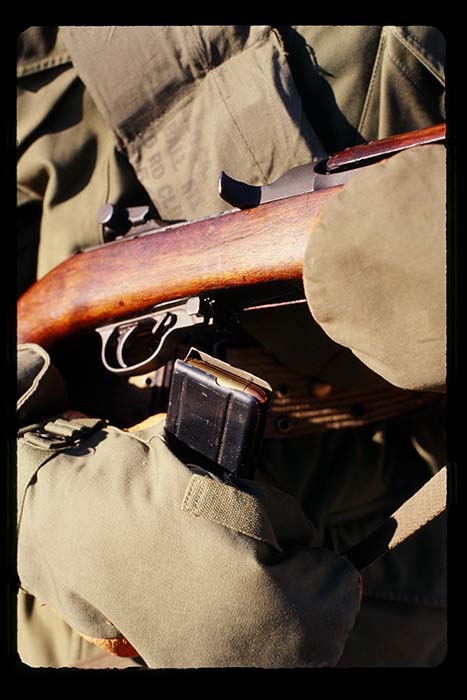

“The rifle is to be the self-loading type, capable of being fired either semiautomatically; that is, one shot for each pull of the trigger; or it should be possible by operation of the selector to fire the weapon automatically…” Military Characteristics for Light Weight Semiautomatic Rifle as Possible Replacement for Cal. .45 Pistol and Submachine Gun, October 1st, 1940
Initial specs for what was to become the U.S. M1 Carbine called for many optimistic design and performance characteristics. With America’s entry into World War II just over a year later, evaluations were accelerated on various designs submitted by America’s most prominent arms firms.
Winchester’s entry – credited in no small part to the colorful character David “Carbine” Williams – was officially adopted one year to the day from when the Ordnance Corps’ requirements letter was published.
Bowing to urgency (and poor initial results in full auto tests) as America‘s entry into World War II became inevitable, the Williams-Winchester “Carbine, Caliber .30, M1” was semiautomatic only.
This one-squeeze-one-shot action didn’t hurt the “Baby Garand’s” immediate acceptance and enthusiastic employment by GIs throughout the war. What its pistol caliber cartridge lacked in stopping power was made up for by light weight, handy compact configuration and the ability to put multiple rounds on target with aimed fire at close to moderate range.
Some think the Army should have left well enough alone at this point under the time-honored principle of ‘if it ain’t broke don’t fix it.’ But clamor from GIs on battlefronts in Europe and the Pacific for rapid fire capability intensified and Ordnance responded.
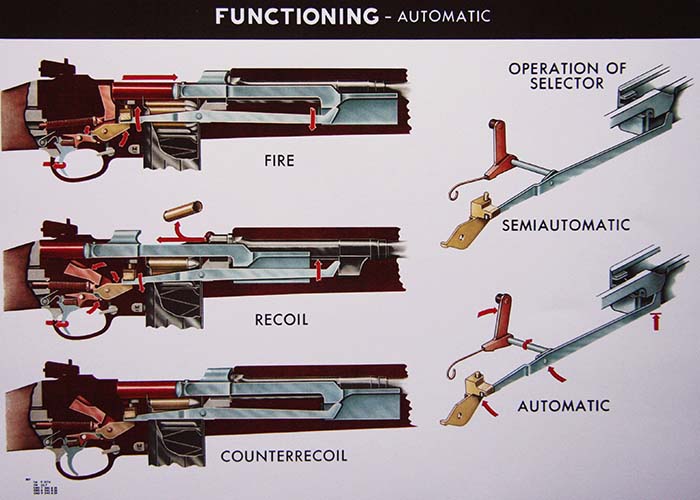
T17 Modification Kit
While several others – notably Winchester and Springfield Armory – began working on a solution to the full auto problem, it was two engineers at Inland whose design soon proved most practical. Fredrick Sampson and Paul Hamish collaborated on a remarkably simple and clever set of parts that could be inexpensively manufactured and then added to existing carbines with minimal difficulty and some readily modified original parts.
When their set was installed, an off-the shelf M1 Carbine became the T4 for Ordnance testing purposes in the latter part of 1944. Performance was quickly found acceptable and the parts were eventually designated “Kit, Carbine, T17.”
Several hundred of Inland’s selective fire carbines with the T4 modification were provided to both the Army and Marine Corps for extensive testing and tactical evaluation. Results were uniformly positive and the T4 became the “U.S. Carbine, Caliber .30, M2” on October 26, 1944. Inland and Winchester quickly got production contracts and it is reported that quantities were delivered in time to take part in the April, 1945 invasion of Okinawa.
“In the spring of 1944 the Army achieved its original goal – a carbine that could be set for full automatic as well as semiautomatic fire… By April 1945, with the collapse of all German resistance in sight, Inland had reached a production rate of more than 100,000 per month. Meanwhile M1 carbines not yet issued to troops were modified for selective automatic fire.” U.S. Army in World War II, The Ordnance Department: Procurement and Supply
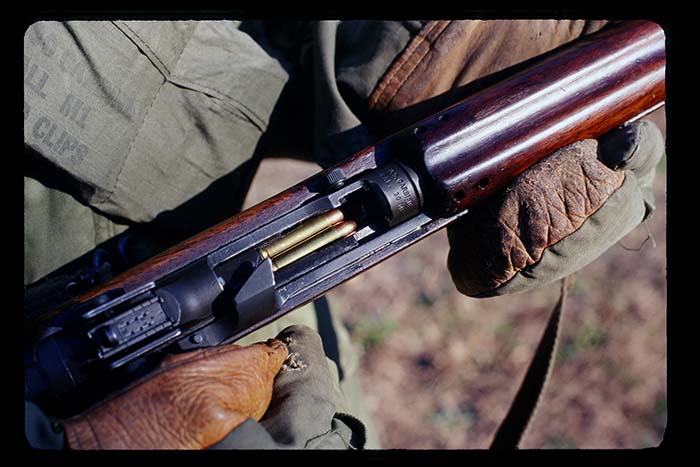
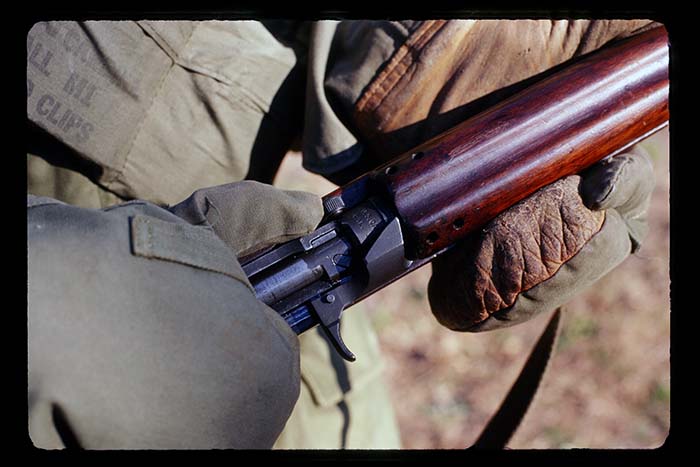
30-Round Magazines
Concurrent with the development of the full auto conversion kits was the need to increase magazine capacity from standard fifteen rounds. What quickly emerged was a longer box with a slightly curved profile, doubling the original supply.
But the added weight of the extra ammo put a strain on the small retention “nibs” that lock the mag into the receiver. This became quite evident in prolonged full auto fire and rough handling in tactical scenarios. The problem was solved by addition of an extra nib to the left side of the 30-round box that was held in place by an “L” shaped extension on a modified magazine catch. The simple and sturdy arrangement allowed use of both existing 15 rounder and the newly-standard 30s.
Also, the new mags gave the carbine a much-appreciated “last round bolt hold open” capability; reminding the gunner that it‘s time to reload. This was a snap to implement by the T18 modification; simply changing the raised portion of the magazine’s cartridge follower from a ramp to a flat stop.
GIs nicknamed this new high capacity feed device the “banana clip,” much to the exasperation of seasoned NCOs who have ever since strived to enforce the proper designation of “magazine.”
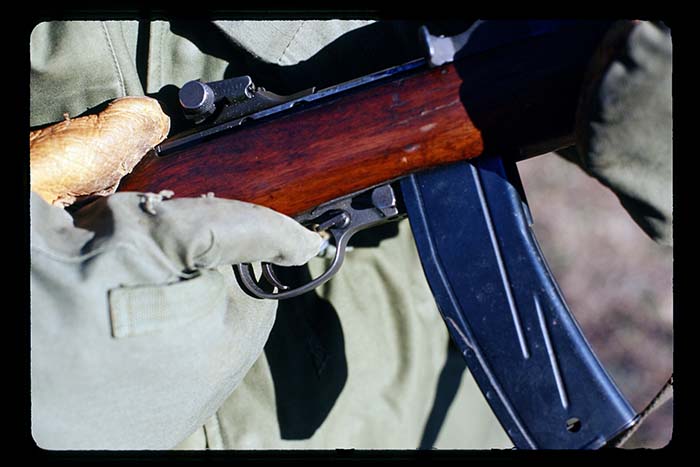
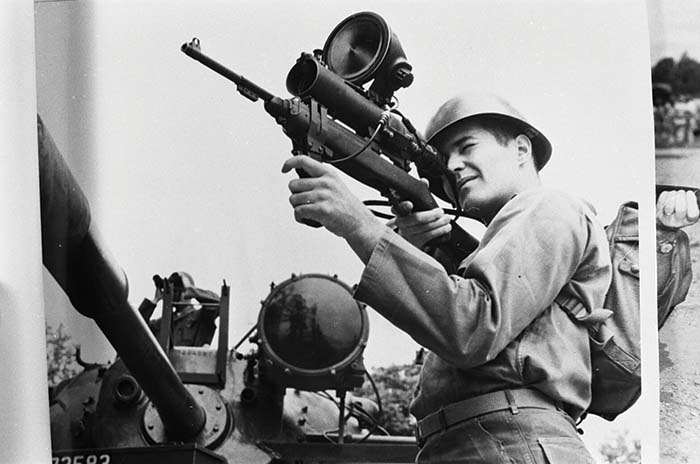
From WW2 to Korea and Vietnam
Relatively few full auto carbines made it into combat in the closing months of WW2 so we pick up the story a scant five years later. U.S. and United Nations allied forces, defending democratic South Korea from the communist North and its Red Chinese and Soviet enablers, were involved in vicious fighting over harsh terrain and in brutal climate extremes.
While combat action reports gave most U.S. infantry weapons high marks for effectiveness, the carbine was not similarly favored.
“The Marine criticism is even more harsh than that of the Army. From top to bottom, 1st Marine Division takes the dim view of this weapon; their experience with it during the Chosin Reservoir operation was the final blow to confidence. They want it either eliminated or made into a dependable weapon.” Operations Research Office R-13, October 1951
What seemed to have gone terribly wrong in Korea with the otherwise serviceable carbine is the inevitable result of some physical factors stacked against it. Particularly when compared with the much-loved and almost unstoppable M1 Garand.
“Since being made full automatic it is hyper-sensitive. In hot weather, even small amounts of dust and moisture together will cause it to misfire. In cold weather, it is more sensitive to frost than any other weapon, and more difficult to lubricate in such a way that it will remain operative.” Operations Research Office R-13, October 1951
By the time the U.S. got heavily involved in Southeast Asia the carbine had been replaced in first-line service by the M14 and later M16 rifles. It did, however, find much favor with America’s native allies who tended to be smaller in stature and not well suited to employ the big, heavy and hard-recoiling M14.
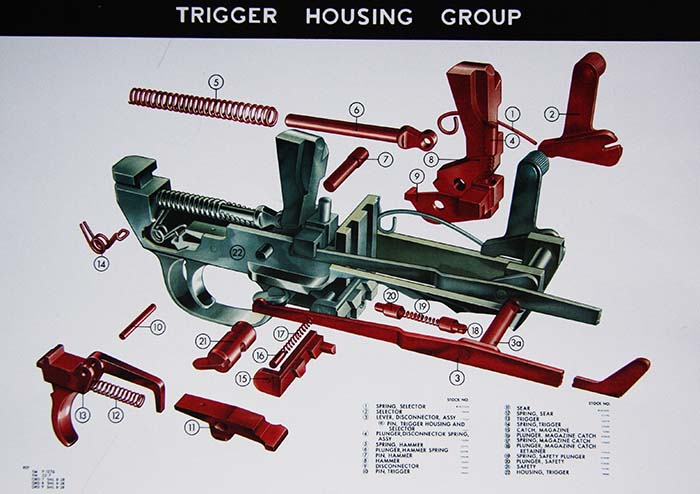
Technical Specifications
(Department of the Army Field Manual FM 23-7, Jan 1952)
The Carbines, Caliber .30, M1, M1A1, M2, and M3 are magazine fed, air cooled, gas operated shoulder weapons. The M1 and M1A1 may be fired semiautomatically; the M2 and M3 may be fired automatically and semiautomatically. The power needed to load and cock the carbine for each succeeding cartridge comes from the expanding gases of the previous cartridge. When fired semiautomatically, the carbine fires one cartridge each time you squeeze the trigger. When the selector of the M2 and M3 carbine is forward on the automatic setting the carbine will fire a number of shots when you squeeze the trigger. The standard magazine holds a maximum of 30 cartridges; the older magazine held a maximum of 15 cartridges. Notes: The M2 and M3 carbines are externally almost identical to the M1 version with the notable exception of a small lever-type selector on the left side of the receiver. The M1A1 carbine, modified to equip airborne troops, is characterized by its side-folding wire stock. Accessories common to all include a canvas web sling, M4 knife type bayonet, M3 cone type flash hider, M1 recoil check (muzzle brake), M8 grenade launcher, and blank firing adapter.
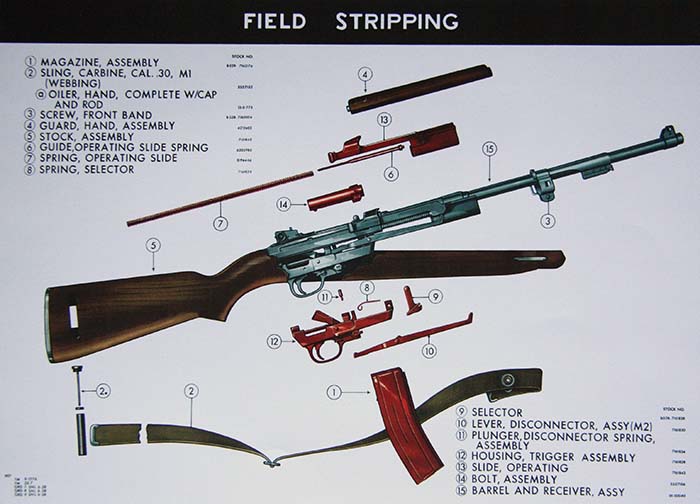
Live Fire
Our live fire session was arranged by modern military weapon enthusiast and ace gunsmith Tom Ring, who thoughtfully provided his Inland-made M1 Carbine with conversion kit.
Tom’s a good sport (and a Marine-for-life), agreeing to don a selection of proper uniform and gear items typical of the Korean War GI as he put the fast-firing little rifle through its paces.
As seen in the accompanying photos, his carbine performed quite well in several hundred rounds in mostly full auto. His comfortable familiarity with the weapon also showed that experience, proper shooting positions and grip go a long way toward taming the six-pound, dozen rounds-per-second mini machine weapon.
Our verdict is that the M2 carbine is well suited for dealing with short range emergency threats. Good enough.
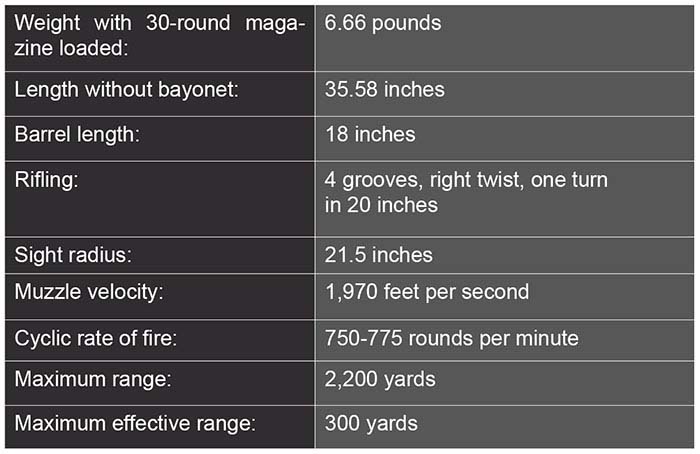
Technical Specifications
(Department of the Army Field Manual FM 23-7, Jan 1952)
The Carbines, Caliber .30, M1, M1A1, M2, and M3 are magazine fed, air cooled, gas operated shoulder weapons. The M1 and M1A1 may be fired semiautomatically; the M2 and M3 may be fired automatically and semiautomatically. The power needed to load and cock the carbine for each succeeding cartridge comes from the expanding gases of the previous cartridge. When fired semiautomatically, the carbine fires one cartridge each time you squeeze the trigger. When the selector of the M2 and M3 carbine is forward on the automatic setting the carbine will fire a number of shots when you squeeze the trigger. The standard magazine holds a maximum of 30 cartridges; the older magazine held a maximum of 15 cartridges. Notes: The M2 and M3 carbines are externally almost identical to the M1 version with the notable exception of a small lever-type selector on the left side of the receiver. The M1A1 carbine, modified to equip airborne troops, is characterized by its side-folding wire stock. Accessories common to all include a canvas web sling, M4 knife type bayonet, M3 cone type flash hider, M1 recoil check (muzzle brake), M8 grenade launcher, and blank firing adapter.
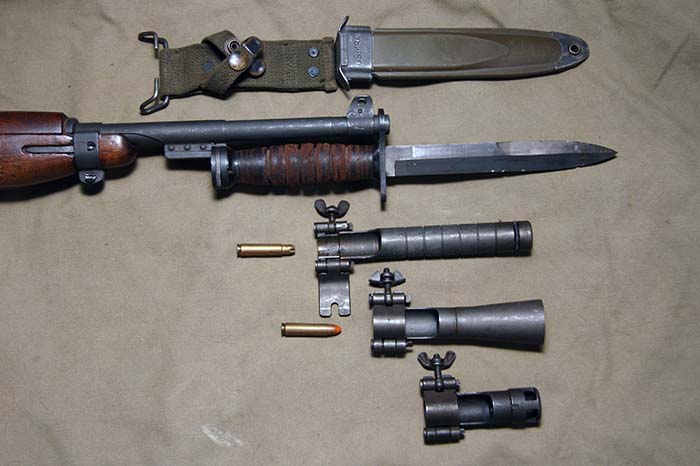
In-Depth Resources
Essential references for this feature and for all who seek in-depth information on evolution of the M1 Carbine are all the product of one extraordinary scholar and enthusiast of all things carbine: Larry L. Ruth. Three in particular are:
M1 Carbine: Design, Development and Production, 1979, Gun Room Press
M1 Carbine Owner’s Guide, 1999, Scott A. Duff Publications
And his two volume magnum opus WAR BABY! The U.S. Caliber .30 Carbine, 1992 and 1993, Collector Grade Publications
Additionally, there is an excellent 14 minute U.S. military training film from later WW2 that’s instantly available on YouTube at (www.youtube.com/watch?v=GqJ5YCszIH0 or search “M2 Carbine.” Interestingly, it ends with a comparison of the M2 with the Japanese Type 100 submachine gun, finding the 8mm enemy sub woefully inadequate.
Important Note
All carbines with the M2 designation stamped on the forward end of the receiver (and “2” overstamped) are classified and restricted as full auto even if there are no M2 parts installed.
| This article first appeared in Small Arms Review V18N4 (August 2014) |










